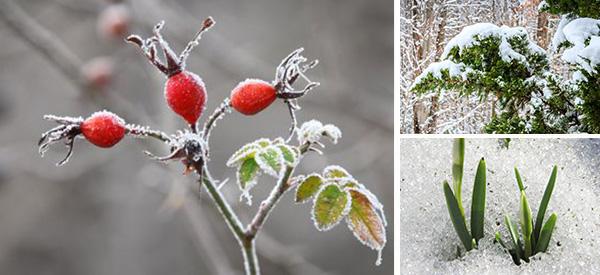
What You Can Forage In The Dead Of Winter
Winter is a magical time of year. Nature grows quiet and cozying up to a warm fire is particularly inviting. While falling into a peaceful hibernation routine is normal, it is worthwhile to wrap up in your warmest clothes and venture out into the forest to find the unique fruits of this special season. Despite the chilly temperatures, and maybe even a few inches of snow covering the ground, winter foraging is possible and plentiful!
Below is a list of things that are commonly harvested in the wild of the winter woods and how to transform these ingredients into flavorful herbal teas to warm your body up after a frigid forage.
Cedar
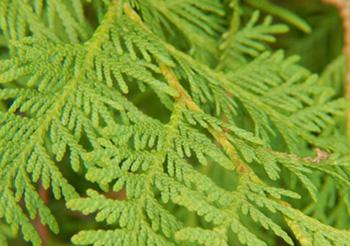 Cedar is a sacred tree often used in ancient and modern-day ceremonies alongside sweetgrass and tobacco to cleanse and purify. Part of the evergreen family, cedar trees have leaves all year round that holds a distinctive, spicy scent. Aside from their ceremonial uses, cedar trees also hold several nutrients that are significant to the detoxification processes of the body. By stimulating the lymphatic system, cedar helps the body release toxins and chronic low-grade inflammation.
Cedar is a sacred tree often used in ancient and modern-day ceremonies alongside sweetgrass and tobacco to cleanse and purify. Part of the evergreen family, cedar trees have leaves all year round that holds a distinctive, spicy scent. Aside from their ceremonial uses, cedar trees also hold several nutrients that are significant to the detoxification processes of the body. By stimulating the lymphatic system, cedar helps the body release toxins and chronic low-grade inflammation.
It also eliminates fluid retention and promotes venous circulation to the kidneys and bladder. Containing active compounds like cedrol, beta-cedrene, and thuiopene, cedar acts as a natural diuretic that assists the body in detoxifying even further. Cedar is often used to help treat fevers and clear phlegm that accompanies colds and flu that are so commonly seen during the winter season. Also rich in vitamin C, it gives your body an immune boost, as well as helps with collagen synthesis to promote wound healing.
Cedar Tea Recipe
- Bring 4 cups of water to a boil in a small pot.
- Add 2 cups of fresh cedar to boiling water.
- Boil for 10 minutes or until the water becomes golden in color.
- Strain tea into a small teapot.
- Sweeten with honey or maple syrup (optional).
Pine
Pine trees are abundant in the strong evergreen forests that stand up against the bitter winter winds. A few of the easiest ways to identify a pine tree is by the way its needles are arranged. Seen in a sharp-tipped bundle (called fascicles) with their seed-producing cones hanging downward, this is different compared to conifer trees (like the fir) that tend to have cones that grow upward from the branches.
If you’ve never foraged for pine before, it’s best to do so with someone who knows how to recognize them or to get a foraging book to reference.
Pine needles are packed with nutrients that assist in several health benefits including maximizing immune health, improving vision, preventing respiratory infections, increasing circulation, improving cognitive performance, and aiding in healing.
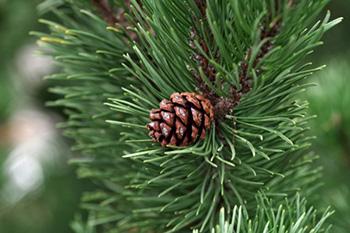
The most notable nutrient pine is known for is its high vitamin C content. Containing more than 5x the vitamin C found in lemons, pine needles deliver a super immune health punch. Also rich in vitamin A, an antioxidant that is important for eyesight, hair and skin regeneration, and production of red blood cells. Pine needles have long been used as an expectorant to help soothe coughs, chest congestion, and sore throats.
Possibly nature’s fountain of youth, research shows evidence that pine needle tea can help in slowing the aging process. Taoist priests would drink pine needle tea regularly to help them live longer.
Pine Needle Tea Recipe:
- Remove fresh needles and rinse in cold water.
- Place needles in a tea mug.
- Boil one cup of water. Once boiled, pour over pine needles
- Let steep for 5 minutes.
- Sweeten with honey or maple syrup (optional)
Black Chokeberries
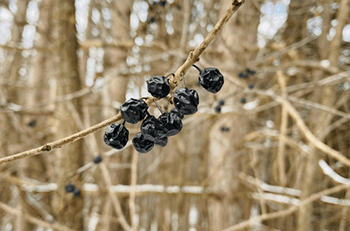 The black chokeberry is an adaptable shrub that produces a deep purple berry fruit that is commonly used to make jams, syrups, teas, and wines. With a wide range of vitamins and minerals including zinc, magnesium, iron, and vitamins C, B, and K, these little winter morsels are bursting with health benefits. Several research studies found positive results on the protective effects chokeberries have on liver health, insulin resistance, and immune function.
The black chokeberry is an adaptable shrub that produces a deep purple berry fruit that is commonly used to make jams, syrups, teas, and wines. With a wide range of vitamins and minerals including zinc, magnesium, iron, and vitamins C, B, and K, these little winter morsels are bursting with health benefits. Several research studies found positive results on the protective effects chokeberries have on liver health, insulin resistance, and immune function.
Its dark anthocyanin phytochemicals are known to reduce free radicals in the blood and decrease oxidative stress in the body. The antioxidant behavior of the black chokeberry is believed to reduce harmful bacteria activity, inhibit cancer cell growth, and decrease overall inflammation. Also known as the Aronia Berry, black chokeberries are best consumed cooked, as the fruit is quite astringent and can produce a mouth-drying effect when eaten raw.
Black Chokeberries Tea
- Dry black chokeberries by setting the oven to 200 degrees F and spreading berries out on a baking sheet. Let dry in the oven for 6 to 8 hours, checking on them frequently.
- Take 2 cups of dried berries and 2 cups of boiling water. Add to a tea mug.
- Cover and steep for 30 minutes.
- Sweeten with honey (optional).
Rosehips
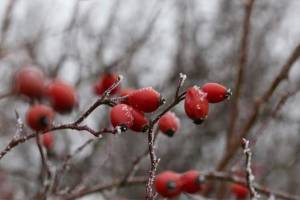 Rosehips are the fruit of roses that replace the flowers once temperatures begin to drop. They can vary in color from red to orange and have an oblong shape with small wisps protruding from the bottom. Fresh, wild rosehips are high in vitamin C with nearly 200% of the recommended daily value in just 1 ounce.
Rosehips are the fruit of roses that replace the flowers once temperatures begin to drop. They can vary in color from red to orange and have an oblong shape with small wisps protruding from the bottom. Fresh, wild rosehips are high in vitamin C with nearly 200% of the recommended daily value in just 1 ounce.
The presence of vitamins A and E coupling with vitamin C makes rosehips hearty in antioxidants and reduces overall inflammation. Its analgesic properties help relieve arthritis and joint pain, while its astringent behavior prevents skin rashes and flare-ups caused by eczema, psoriasis, and acne. Polyphenolic compounds and the presence of leucoanthocyanins help to reduce systolic blood pressure and cholesterol levels, making them heart-healthy fruits. Lastly, rosehips are helpful in digestive health. Its anti-inflammatory properties soothe the tissues in the gut to help regulate bowel movements, relieve constipation, eliminate toxins, and ensure proper nutrient absorption.
Rosehip Tea
- Dry rosehips by setting the oven to 200 degrees F and spreading fruit on a baking sheet. Let dry in the oven for 6 to 8 hours, checking on them frequently. Once dry, crush rosehips into smaller pieces.
- Boil 1 cup of water in a small pot.
- Place rosehips in a tea mug. Once water is boiled, pour over rosehips.
- Let steep for 15 minutes, then strain out the pulp.
- Sweeten with honey (optional).
Turkey Tail Mushroom
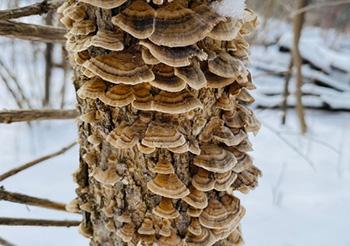 Turkey Tail Mushroom commonly grows on fallen logs or tree stumps all year round. Although they vary in color, one thing that is common throughout all turkey tail mushroom species is its resemblance to a turkey’s tail. Known as a bracket fungus, because of its shelf-like form, its job is to break down lignin or cellulose in rotting wood. The one way to decipher a true turkey tail mushroom from an imposter turkey tail imposter is its underside.
Turkey Tail Mushroom commonly grows on fallen logs or tree stumps all year round. Although they vary in color, one thing that is common throughout all turkey tail mushroom species is its resemblance to a turkey’s tail. Known as a bracket fungus, because of its shelf-like form, its job is to break down lignin or cellulose in rotting wood. The one way to decipher a true turkey tail mushroom from an imposter turkey tail imposter is its underside.
True turkey tail mushroom will have a polypore appearance, which looks like tiny holes covering the entirety of the underside. Used as a treatment for liver disease for over 2,000 years in traditional Chinese medicine, the turkey tail mushroom is a potent liver protector.
Lush with beta-glucan polysaccharides, a nutrient that stimulates white blood cells to release cytokines, the turkey tail mushroom is an immune system soldier that helps kill invading pathogens. Turkey tail mushroom also helps increase GABA (gamma-aminobutyric-acid) production in the brain. By helping balance out neurotransmitters, turkey tail mushroom extract can decrease irritability, restlessness, and mood swings in individuals experiencing anxiety and/or depression. Its extracts also increase Bifidobacterium production, an essential microbe that helps nourish the gut and supports digestive tract function.
If you can’t find Turkey Tail in the forest, Turkey tail tincture is available in the Apothecary.
Turkey Tail Mushroom Tea
- Chop turkey tail mushroom into small pieces. Add to a large pot of water on the stove.
- Bring water to a boil, then simmer for 1 hour to 1 hour 15 minutes.
- Strain the mixture.
- Optional: add loose leaf tea to hot water for added flavor (chamomile loose leaf tea is pictured).
Chicory Root
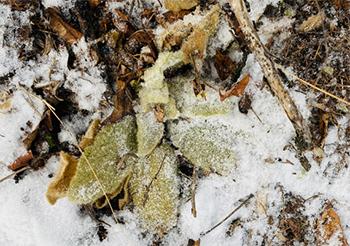 During the summer, chicory is easy to spot due to its vibrant, blue colors. While the blue flowers disappear during wintertime, chicory leaves often remain green, making it easy to find in a landscape covered in glistening, white snow. Chicory is a scraggly-looking plant that is most often found in areas that get ample amounts of sunlight, such as fields or along with gravel areas.
During the summer, chicory is easy to spot due to its vibrant, blue colors. While the blue flowers disappear during wintertime, chicory leaves often remain green, making it easy to find in a landscape covered in glistening, white snow. Chicory is a scraggly-looking plant that is most often found in areas that get ample amounts of sunlight, such as fields or along with gravel areas.
Rich in inulin fiber, chicory root promotes a happy functioning gut by helping food pass more easily through the digestive tract. Inulin is a soluble fiber, meaning it holds water in the intestines, helping you to feel fuller longer. It also aids in lowering blood sugar and decreasing insulin resistance. Containing high amounts of manganese and vitamin B6, chicory root gives a major brain health boost.
Manganese is a vasodilator with antioxidant properties. It helps improve blood flow and increases the speed of electrical signals to improve overall brain function. Vitamin B6 is also a vital nutrient in brain function, as it is needed to create certain neurotransmitters. Chicory root is most known for its use as a coffee replacement due to the warming coffee flavor you get after roasting it in the oven.
Chicory Root Coffee
- Mince chicory roots with a knife.
- Set oven to 350 degrees F. Arrange chicory pieces on a baking pan and toast until golden brown and pieces have a coffee-like smell.
- Grind roots up into a powder.
- Mix chicory with ground coffee (the ratio is up to you, it is easy to start with a 2:3 chicory-to-coffee blend at first).
- Brew coffee as you regularly would.
- Add foam, cream, honey, or any other flavorings to enhance your chicory root coffee.
After a cold winter forage, nothing is better than warming up next to a fire with a hot herbal cup of your forest finds. As every season has its magic, winter falls far from short with what it has to offer your health and your kitchen cabinets in nutritious foods. Harvest safely, and enjoy being in the wilderness connecting with mother nature!
Also, with the cold and influenza season in full swing, we need all the help we can get to keep our immune systems healthy and strong. Here are a few of Nicole’s top picks that are found in our Essential Winter Defense Bundle. Whether maintaining lung health, boosting immunity, or reducing fevers, each herb supports overall well-being this winter and beyond.
15 Things You Could Forage in Winter
Stop Spending Money At The Pharmacy By Growing These 10 Plants (Video)
5 Winter Herbs To Cut Belly Fat
Soothing Elixir For Cold and Flu Season
DIY Colon Detox with Ingredients You Have in Your Kitchen Right Now

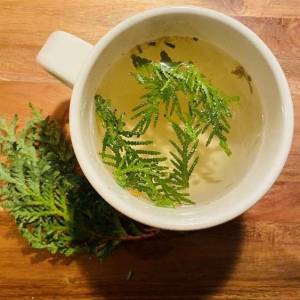
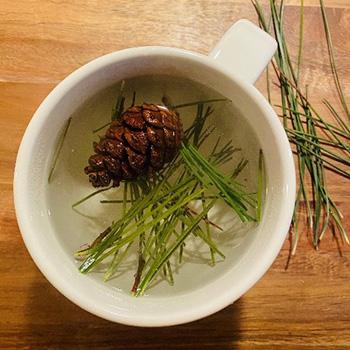
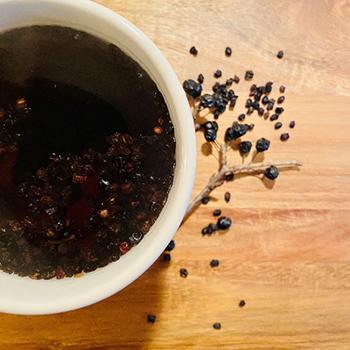
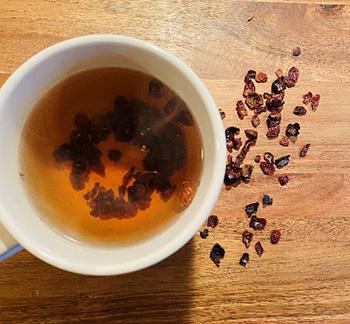
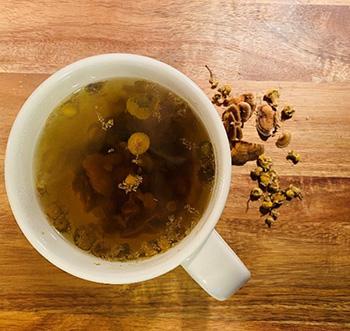
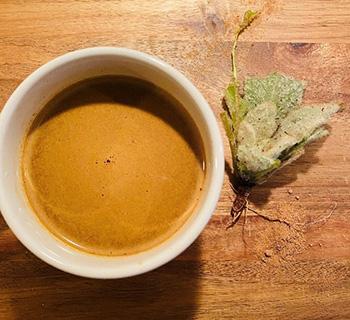

I do not like Tea!! Why do all the recipes only make TEA?? Why not show/tell us OTHER Ways to use these herbs??
Tea is awesome… How can you not like it? These type of herbs are best steeped and therefore best in a tea. You can certainly try them in powder form and use it in cooking as you would with salt, pepper and spices. Or you can get used to drinking tea – cold or hot.
Respect her agency. Everybody has their own likes and dislikes, even you.
You can soak herbs in alcohol ( a tincture) or in oil (an infusion) and take those by dropper or spoonful. Certain herbs are better done this way because more nutritive/medicinal qualities are drawn out by alcohol/oil than water. Look these up on the internet or in a good herbal for metods, dosages, etc.
Add small amounts of any type of herbs to your cooking. This way, you will keep your body healthier.
I suppose technically it is not “tea” because it is not from tea leaves. It’s more just an extract. So do you not like tea or not like any sort of extract? What do you drink?
Actually, Mike, the ‘tea’ you refer to is the plant Camellia Sinensis. TEA is the extraction of plant parts into warm to boiling water. Consider herbal teas. Not disagreeing with you, just further informing you.
You are absolutely correct Mike. “Tea” comes from a specific plant, Camellia Sinensis. .People have a tendency to refer to herbal infusions as tea. Has become common usage but is incorrect. There was no chamomile and invited to the Boston tea party.
http://highqualitytea.com/
Well tea is the easiest form for beginners to make! I assume you can use things ground to put in food or make a tincture or such. Look in her book. It tells you all sorts of ways to use plants
Just think about the flavors. Turkey tail could easily be added to soup or coffee. The pine, cedar and berries could be used in a vinaigrette or added to a different beverage like fizzy water. It takes experimenting. If you don’t want to do that but want the health benefits, go buy it in capsule form
Maybe you can just eat the herbs google likely could help find other ways to ingest
.like grinding into a capsule form or pill form..I can’t imagine a food that tastes good with some of these herbs..alltho some spices are herbs..I appreciate this information but google searches ect definitely there’s much more information to be found when you look..some people make tablet like forms or syrup like forms or tinctures either vinager or alcohol the book that is sold or other books offer information as well there’s many ways to incorporate herbs into healing forms other than tea
Its because its the easiest way to get it into the body and is more efficient than just eating it.. i didnt like teas at first either, but you get used to it..
I make a double tincture out of turkey tail mushrooms. I grind the mushrooms to get mor surface area and just soak them in a high proof grain alcohol for about two months, then strain the mushrooms out of the alcohol and then simmer the mushrooms for several hours, making sure the water doesn’t steam away and mix the water with the alcohol at about 1 to 1 ratio, put in a dropper bottle.
I like tea. Think of it…made from leaves, trees,roots ,shoots, much of all that grows. There’s no such thing as a weed. The Word of God states that God made the grass for cattle and the herb for the service of man. Psalm 104: 14,15
Well, since it’s winter, the berries and mushrooms are dried up, the flowers are gone, and the roots are hard to dig. Re-hydration is about the only option. Plus, a lot of herbs don’t taste too great as an entree and could over-dose you, hence teas, tinctures, and tonics. You could add berries to oatmeal or stews or use like you would raisins. Rose hip jelly is a thing but I suppose all the sugar de-values it as a medicinal. I’m with you, Appyhorsey, not a big tea drinker. I do like chicory as a coffee substitute though. It’s New Orleans style and caffeine-free. Winter is a difficult time to forage anything, especially as food. This was a good list!
Can you get the same benefits from store bought chicory coffee?
Hi Patsy,
Generally, homemade recipes are healthier than store-bought varieties, because you can control the ingredients used. They are also cheaper to make.
But some of the store-bought chicory coffees are actually very good. Just make sure to buy from a reputable source and read the entire label of ingredients.
Many blessings and good health!
Chicory Root Roasted Granules
https://amzn.to/3ggjEFy
Coffee and Chicory
https://amzn.to/34rwPkk
Yes. We actually buy dandiblend which is chickory, dandilion and roasted barley.. it makes a great coffee substitute and isnt as bitter but is more like instant coffee
Dandy Blend
https://amzn.to/3AWphCb
For anyone looking. Gluten from barley and rye is removed.. May be suitable for those with celiac. Check with your doctor. And see the 2 lbs. package for $3 more.
I also have used Dandiblend as a coffee substitute and love the taste. There used to be an Amish grocery store near me that sold it but they closed. Where so you get yours?
Love all your info. Would love more
Can I forge Chicory root, RoseHip and chokeberries in southern Al.
Do they grow this far south, as the weather is not as cold as the north?
Hi Carldene,
Chicory, Rosehips, and Chokeberries can be found growing wild in many areas of the U.S., including AL.
You can also check out The Forager’s Guide to Wild Foods. (400 Wild Plants That You Can Forage For). With the distribution map we added, you will also be able to search only for plants growing in your area.
You can purchase the book using this link below:
https://www.digistore24.com/redir/391224/globalbro/C2
You can also check some of the local newspapers and foraging blogs:
https://alabamanewscenter.com/2019/08/11/alabamas-wild-eats-foraging-for-your-grub/
Many blessings and good health!
Thank you for reminding me of pine needle tea, which is also an antiviral – it contains suramin, shikimic acid.
Will any pine work, or just white pine?
Any pine will work, but I prefer the taste of the White myself.
Nicole, I thank you so much for what you are doing! I already have several books by you and Claude, including your Forager’s Guide. What a God Send you are!
I love your posts. I would like to know if you could tell us if the herb doesn’t mix with certain pharmaceuticals as my husband is on many of them and I would like for him to go with more natural medicines.
Right now, in the PNW, cedar is blooming and dropping a huge amount of pollen. So, if you are allergic, beware. I have cedar pollen in places on my driveway right now. Very yellow patches below the cedar trees.
How much of something to use would be helpful.
The needles and resin of some pines are toxic. It would be helpful to include a list of safe and toxic varieties and how to identify them.
I also want to know if any type of pine is alright to use. I heard there is a difference in 3 to 5 needle bundle and length
The article said turkey tail increases GABA.
GABA greatly increases dreams. I have had long dreams two days after taking a GABA pill so turkey tail mushroom should increase dreams during sleep.
LOL, my father used to have crazy dreams after eating chili
Witches Butter Mushrooms, Tremella mesenterica, are most often used for respiratory problems but have many other benefits due to their polysaccharides. Some people claim they can be eaten raw in the woods, but that’s risky. ANY fresh picked and unwashed mushroom MAY harbor various parasites, and they should at the very least be steamed before being eaten, unless they’re going to be dehydrated. Diabetics should use caution with Witches Butter due to possible cytokine storm issues.
I had the flu. I am using cedar needles to soothe my throat and clear up congestion. It works. Used it as a tea.
Thanks for sharing!
I made a Tincture using Fresh Cedar branches/leaves heated very slowly in EVO for 2-3 days on and off in a dbl boiler. Now a rich dark green color. With that intensity should there not be a strong Cedar smell?? Did I do something wrong. I also made a tea which was excellent!
Hi, I thought the stiff needled pines (the picture shown) could possibly be poisonous., am I mistaken? One should always identify what they use for food!
I know white pine with flexible needles and long cones (5+inches) is used for tea, unless you have pine allergy.
The photo of chicory looks like mullein, ?
Otherwise great content. Thank you